Key takeaways:
- A literature review is crucial for synthesizing existing research and revealing gaps or new perspectives, rather than merely summarizing sources.
- Identifying key research questions involves reflecting on personal interests, engaging in discussions, and reviewing existing literature thoroughly.
- Efficiently gathering relevant literature can be enhanced through targeted keyword searches, advanced search options, and the use of reference management tools.
- Structuring the review thematically and incorporating personal insights can enrich the narrative and enhance reader engagement.
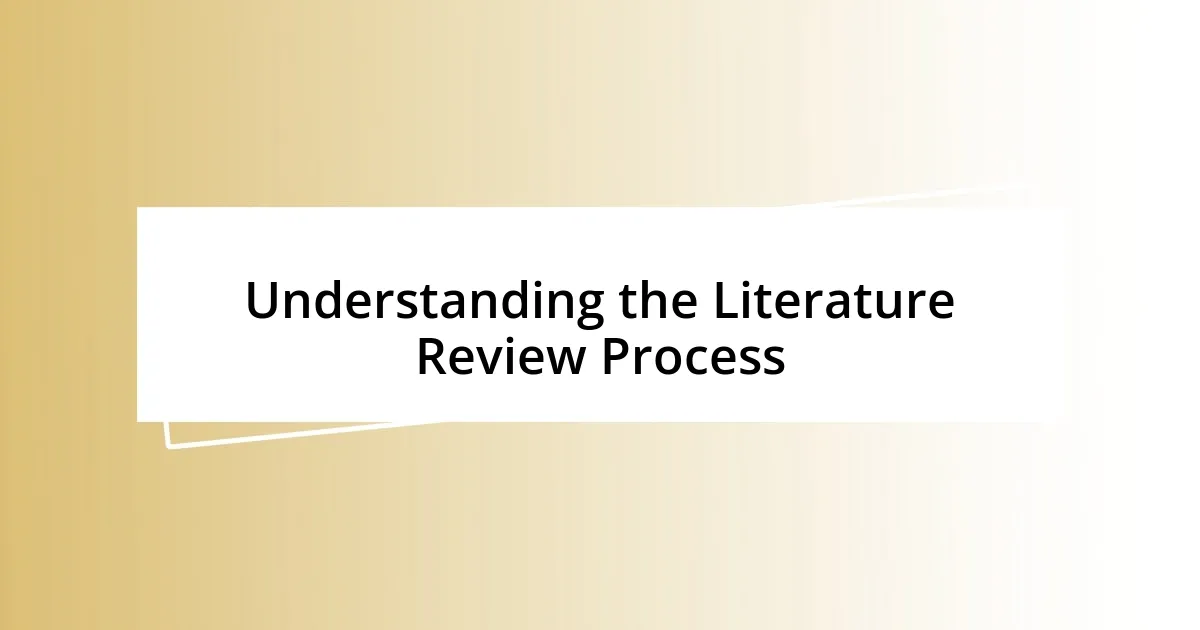
Understanding the Literature Review Process
Understanding the literature review process can initially feel like a daunting task. I remember my first experience diving into it; I felt overwhelmed by the sheer volume of existing research. It was like standing at the foot of a mountain, unsure of how to climb it. But each article I read was a small step forward, guiding me along the way.
One key aspect to grasp is that a literature review isn’t just a summary of sources. It’s an opportunity to synthesize and analyze what others have said, revealing gaps in the research or presenting new perspectives. Have you ever noticed how a single study can illuminate a completely new angle on a topic? This was a revelation for me during my own reviews; connecting the dots between different authors’ insights enriched my understanding and equipped me to contribute to the conversation.
As you embark on this process, consider how each piece of literature serves to build a foundation for your own work. I often found it helpful to take notes, jotting down my reactions and thoughts alongside key findings. This practice not only made my literature review more personal but also transformed it into a living dialogue between my voice and those of the researchers I was studying. How do you plan to engage with the literature in your own unique way?
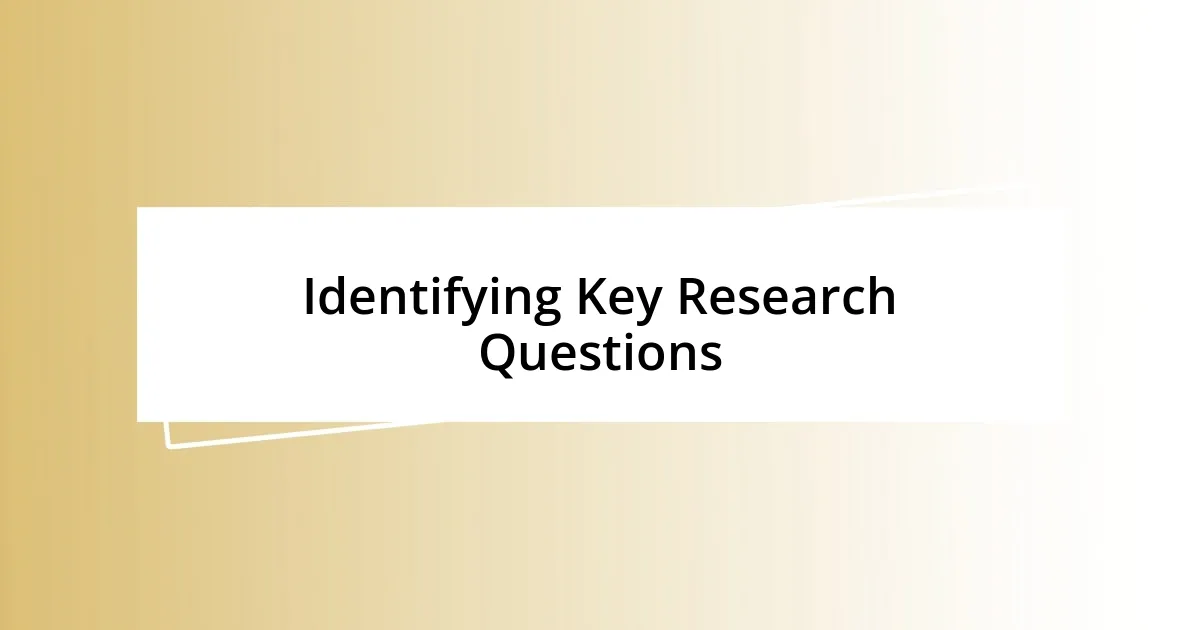
Identifying Key Research Questions
Identifying key research questions is a crucial step in the literature review process. I often start by reflecting on the aspects of the topic that intrigue me the most. For example, during one review, I identified a gap regarding the impact of social media on mental health in teenagers. This realization not only guided my research focus but also sparked a genuine passion for exploring how digital interactions shape young minds.
Once I pinpoint a compelling question, I find it beneficial to discuss it with peers or mentors. Their insights can unveil perspectives I might have overlooked. I remember a time when a simple brainstorming session with my colleagues led us to consider the ethical implications of our research methods. Those discussions can open doors to research avenues that enhance the depth and relevance of my findings. It’s surprising how collaborative discussions can lead you to refine your questions significantly and ultimately enrich your literature review.
Another vital technique for identifying research questions is reviewing existing literature thoroughly. While eating lunch one day, I stumbled upon an article that posed a unique perspective on educational strategies in remote learning. This sparked my curiosity about how these strategies affect student engagement. I realized that passionate curiosity is a powerful driver in formulating insightful research questions. What unknowns are you eager to uncover in your own research?
| Strategies for Identifying Key Research Questions | |
|---|---|
| Reflect on Personal Interests | Incorporate gaps you’ve noticed in the literature to shape your question. |
| Engage in Discussions | Leverage conversations with peers for fresh perspectives and refinement. |
| Thorough Literature Review | Analyze existing studies to spark curiosity and develop your original questions. |
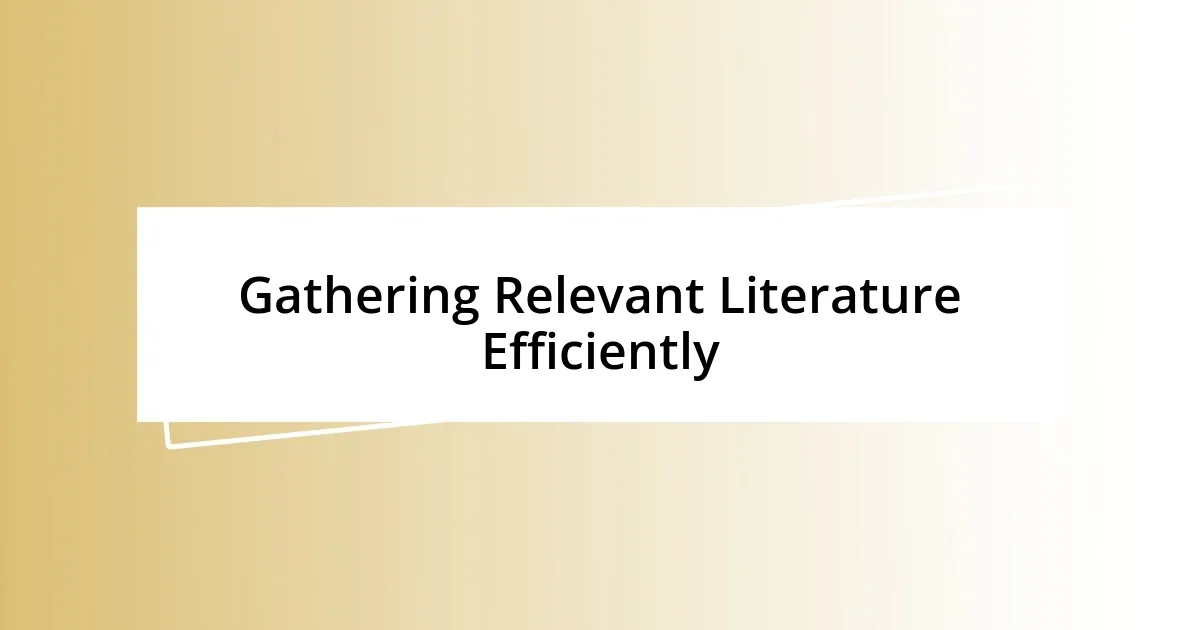
Gathering Relevant Literature Efficiently
Gathering relevant literature efficiently is a skill I’ve honed over time. Early on, I often spent hours tangled in a web of unorganized research without direction. To streamline this process, I developed a habit of using targeted keywords when searching databases. By focusing on specific phrases, I learned to cut through the noise and find literature that truly resonated with my research aims. Believe me, this approach saves time and keeps frustration at bay, turning what once felt like a chore into a more enjoyable and stimulating endeavor.
Here are some strategies that have worked wonders for me in gathering literature:
- Use Advanced Search Options: Most databases offer filters like publication date, peer-reviewed status, and specific fields like title or abstract, which help narrow your results.
- Set Up Alerts: I regularly set up alerts for key topics. It’s exciting to be notified whenever new research is published, keeping me in the loop without constant searching.
- Leverage Citation Trails: Following the citations in a promising article is like embarking on a treasure hunt. I often discover hidden gems that provide valuable insights and complement my research.
- Organize with Reference Managers: Tools like Zotero or EndNote greatly simplify the management of sources. I remember the satisfaction of seeing my organized library grow as I added notes and highlights directly tied to my ideas.
By implementing these techniques, I not only gather literature more efficiently but also cultivate a deeper engagement with the material. The literature review process becomes not just a task, but an exploration that fuels my academic curiosity and creativity.
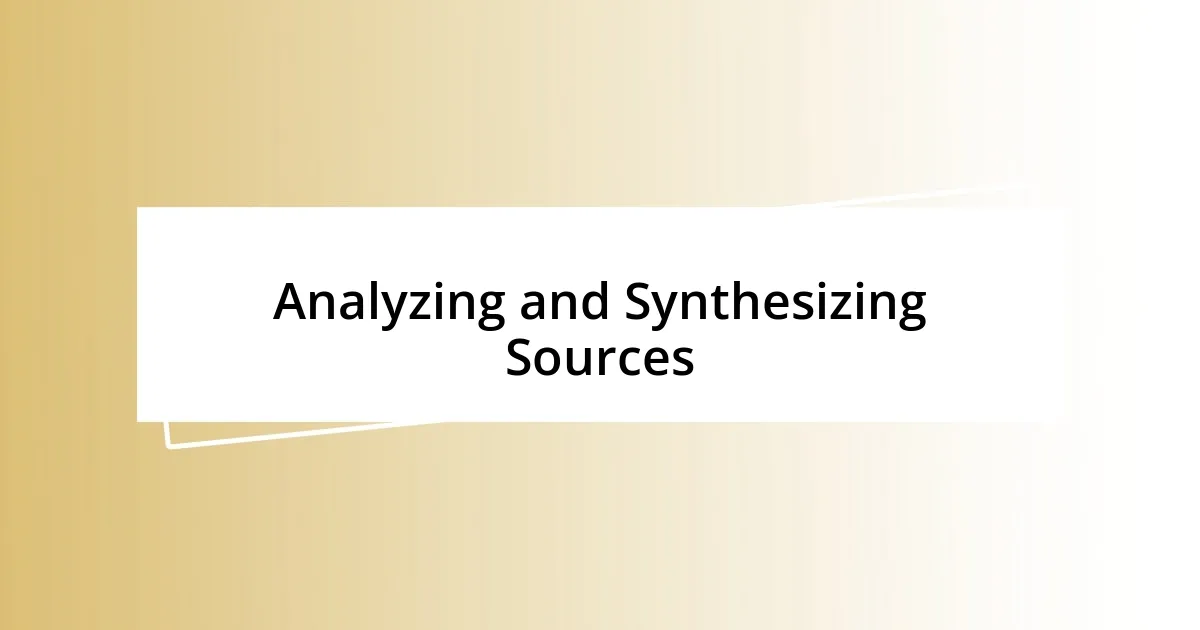
Analyzing and Synthesizing Sources
Analyzing sources isn’t just about reading; it’s about understanding the nuances of what each author brings to the table. I remember diving into a particularly dense study on cognitive behavioral therapy (CBT), where the methodology felt overwhelming at first. However, as I dissected each section—methods, results, and discussions—I uncovered not only what worked but why it mattered. Have you ever felt that moment of clarity when a complex source suddenly makes sense? It’s like the pieces of a puzzle falling into place, revealing a bigger picture.
When it comes to synthesizing information, I often create thematic charts that allow me to visually map connections between sources. This technique proved invaluable during my analysis of varied theories on emotional intelligence. I grouped studies by common themes, highlighting similarities and discrepancies. This visual representation not only deepened my comprehension but also made my final arguments stronger. I can’t stress enough how this method can transform your approach—do you have any strategies that bring your sources together cohesively?
One of my favorite aspects of synthesis is weaving personal insights into the academic discourse. During a review of literature on online learning’s effectiveness, I shared my own experiences transitioning to virtual classrooms. Integrating personal anecdotes can not only humanize your review but also provide a unique lens through which to analyze the literature. Have you thought about how your experiences might enrich your synthesis? Embracing this narrative approach can foster a more engaging and reflective literature review process, making your insights both relevant and impactful.
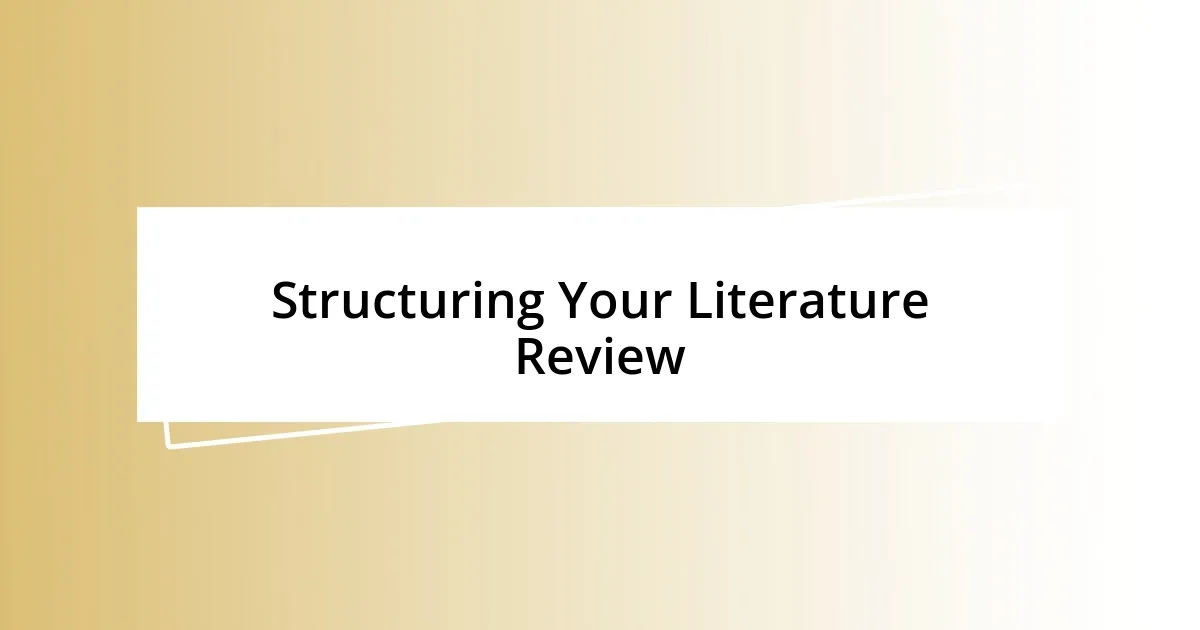
Structuring Your Literature Review
Structuring your literature review can be one of the most rewarding parts of the research process. From my experience, laying out a clear framework not only helps keep the analysis organized but also aids in highlighting the relationships between various studies. One approach that has worked for me is creating an outline before diving into the writing. This outline acts like a roadmap, guiding me through key themes and arguments while ensuring I stay on track. Have you ever tried mapping out your thoughts before writing? It can truly transform how you approach the review.
As I structure my literature review, I often find it effective to group studies thematically rather than chronologically. For instance, while reviewing literature on childhood education, I categorized sources into topics like personalized learning, social-emotional development, and technology integration. This method helped me see patterns emerge and illuminated areas where the research was lacking, making it much easier to engage in meaningful discussion. Isn’t it fascinating how viewing studies through this thematic lens can shift your perspective?
Another strategy I rely on is to intersperse personal reflections within the structure. While discussing a framework related to environmental policies, I recall my own struggles advocating for eco-friendly practices in my community. Sharing such anecdotes not only enriches my arguments but also invites readers into my thought process. Have you ever considered how your own experiences can complement the academic research? By incorporating personal insights, you can create a more dynamic dialogue that resonates with readers, making your literature review both informative and relatable.
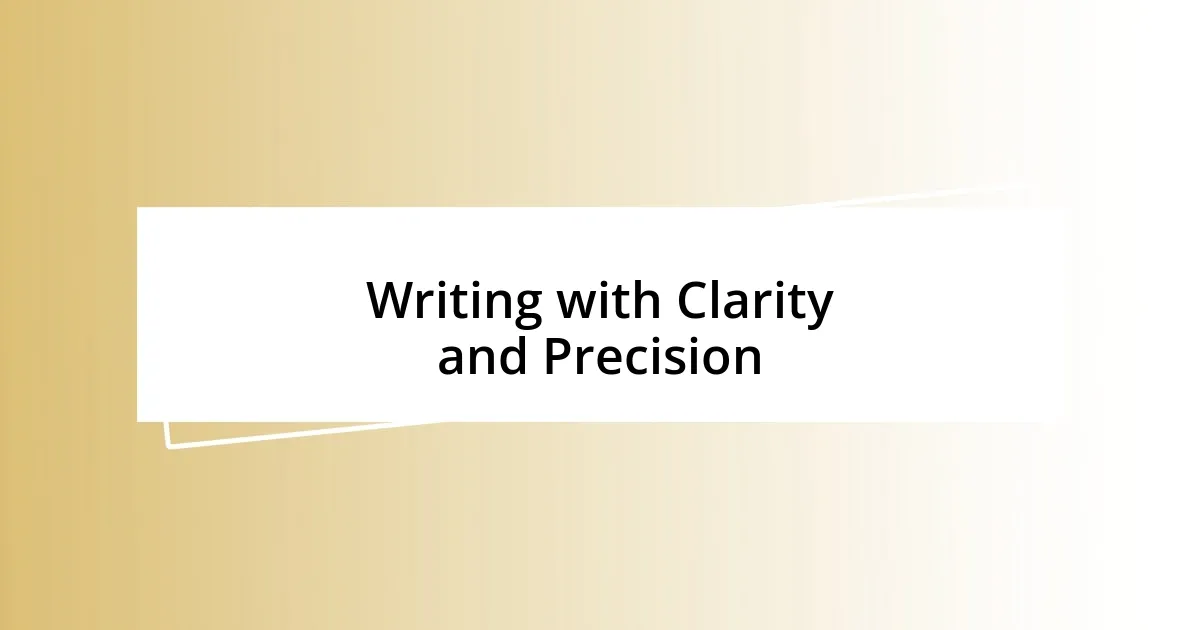
Writing with Clarity and Precision
Writing with clarity and precision is essential in any literature review. I often remind myself that being straightforward can significantly impact how readers perceive and interact with the material. For instance, during one of my literature reviews, I focused on the implications of mindfulness in education. I found that using concise language helped convey complex ideas, making them accessible to a broader audience. Have you noticed how clarity invites engagement? It opens doors for deeper conversation.
When crafting sentences, I strive to choose words that convey exactly what I mean, avoiding jargon unless absolutely necessary. In one review, I wrote about the importance of urban green spaces for mental health. Instead of saying “these areas provide beneficial externalities,” I opted for “parks help us feel better.” This small adjustment made my point more relatable. Don’t you think that simplicity can often have a more profound impact? It connects the reader to the core of the argument without unnecessary complexity.
In my experience, precision doesn’t only lie in word choice but also in structure. I’ve learned to carefully construct my paragraphs to maintain a logical flow. For instance, while discussing the challenges of remote education during the pandemic, I placed each idea in a way that built on the previous one, like crafting a story. This technique helped create an emotional arc, making it clear how each challenge compounded the last. Have you ever thought about how your writing’s structure can lead your readers through your thought process? By guiding them step by step, you foster understanding and create a more engaging narrative.












